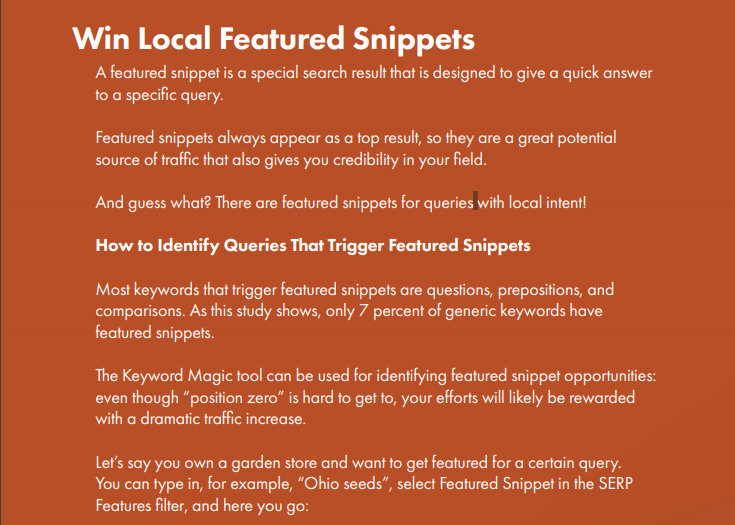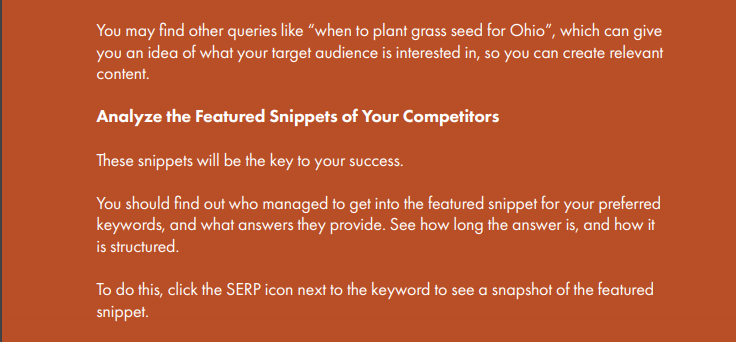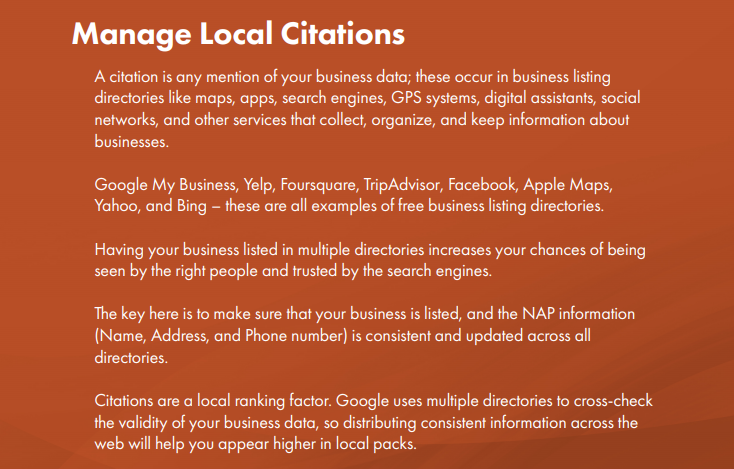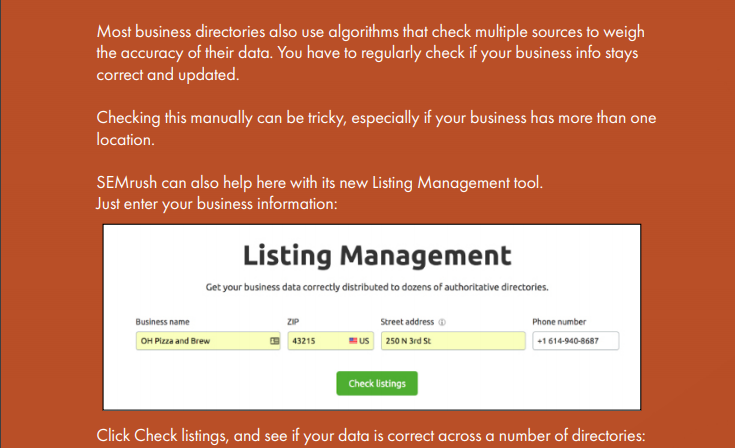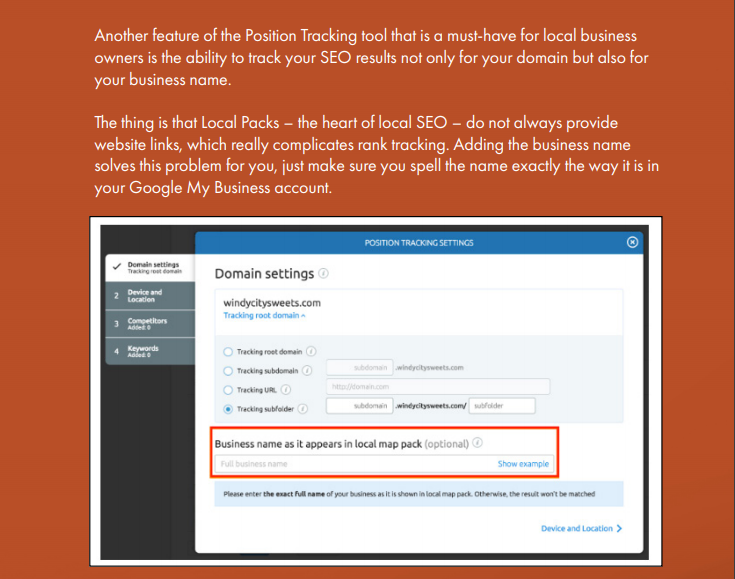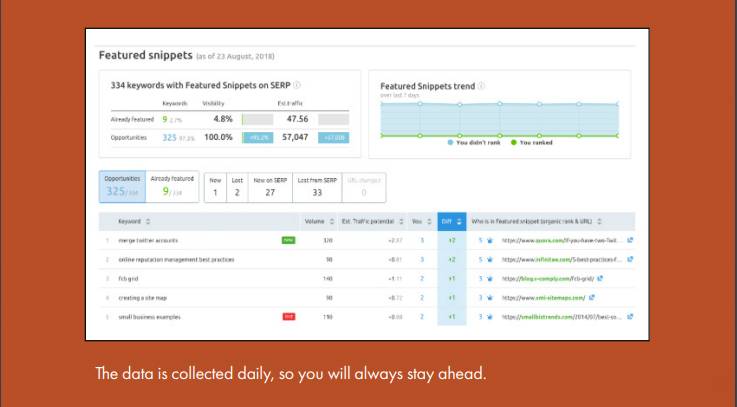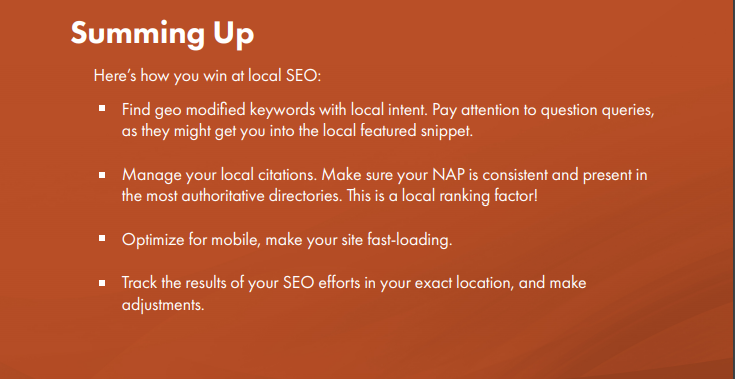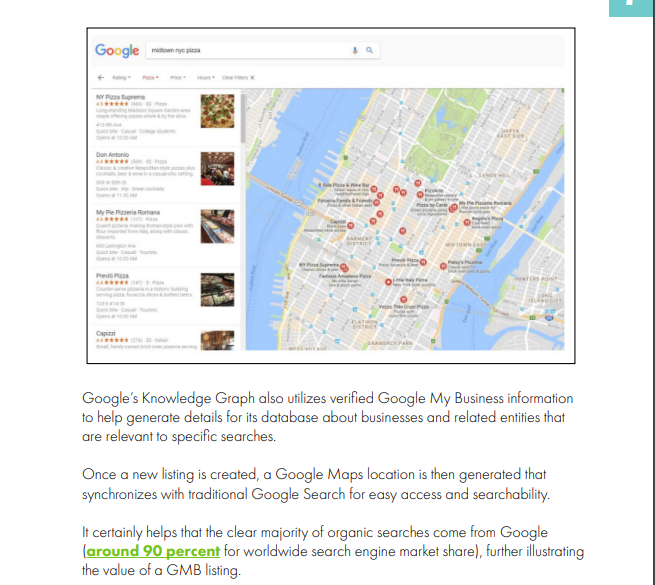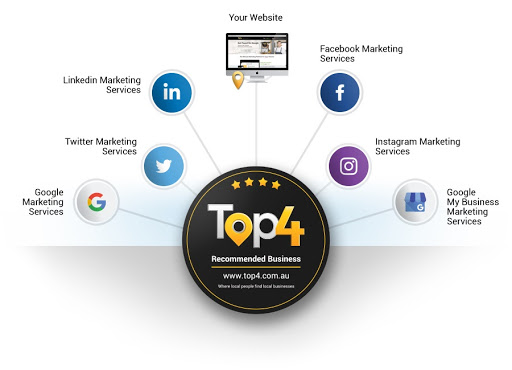CHAPTER 1
WHAT IS LOCAL SEO & WHY LOCAL SEARCH IS IMPORTANT
Local search engine optimization is a branch of SEO that is focused on the optimization of a website for local search
WHY LOCAL SEARCH IS IMPORTANT
Here are a few stats that prove how important local search continues to be for businesses:
- 50 percent of people who did a local search on their phone went to a physical store within one day.
- 34 percent who did their search on a computer or tablet did the same.
- 18 percent of local mobile searches lead to a sale within one day.
- 60 percent of American adults conduct searches for local services or product information on tablets and smartphones.
- 50 percent of searchers on their mobile phones who conduct local searches are looking for things like a local business address.
- 78 percent of local-based searches on a mobile device end in purchases being made offline.
- 71 percent of people who have been surveyed have said they search for the location of a business in order to confirm its existence before going there for a first-time visit.
- 1 in 3 searches on a smartphone was conducted just before arriving at a store.
- 97 percent of consumers looked online for local businesses in 2017, with 12 percent looking for a local business online every day.
WHO BENEFITS FROM LOCAL SEO & WHY?
Lawyers & Law Firms
The reason why this is such a huge benefit is that anyone who has been in an accident or has another issue will be on the phone attempting to find attorneys who offer free consultations.
When done right, local SEO will push the attorney to the top of the search results for that location, and the dominant call to action will be the “call us” button.
Doctors & Medical Practices
When someone is searching for a doctor, in my experience, it has been that someone is always searching for a doctor nearby or a doctor “near me.”
When it comes to doctors, people are more comfortable calling to set an appointment, and they are most likely looking for an easy way to look up directions to the doctor’s offices.
Plumbers
The Google search results provide an easy way for someone to call a plumber directly, read reviews, and access local plumbers immediately if they have such an emergency
Restaurants
These businesses achieve the most benefit from local SEO because of the immediacy of customer reviews and local address information prevalent in the search engine results pages (SERPs).
WHO WON’T BENEFIT FROM LOCAL SEO?
While, as SEO professionals, we would love to see everyone benefit from local SEO and sell these services to more clients, the reality is that some businesses just don’t lend themselves well to local SEO efforts. Businesses like online-only ecommerce shops, local authors, businesses that don’t want to share their local information, and private online sellers who want to keep their information private are likely not great candidates for local SEO services.
WHAT ARE THE IMPORTANT PARTS OF LOCAL SEO?
When it comes to local SEO, it isn’t all that different from organic SEO – keyword research, content, links, and on-page technical SEO. It just has a local focus. These elements are important to get right for your website and its industry overall in order to outperform the competition in the SERPs. When optimizing for local search, however, these parts contain more of a local focus on searches people are performing in the immediate area surrounding the business (e.g., local city names)
KEYWORD RESEARCH
Keyword research for local SEO has not changed all that much, although some aspects are a little bit different. Now, statistics show that people have more access to devices like smartphones, Amazon Echo, and Google Home. These devices pave the way for voice search to be one of the primary avenues of executing local searches. It’s easier to say “find a doctor near me” or “find a plumber near me” for most people than it is to type. Thus, it isn’t surprising to see a rise in local queries based on conversational voice search. If your industry is service-oriented, try out keyword variations that include questions.
THE IMPORTANCE OF CONTENT TO YOUR LOCAL SEO EFFORTS
Content with a local focus has a significant importance on local SEO efforts. Depending on your industry, content with local focus, depth, breadth, and knowledge tends to do well.
Writing custom local content with all of these factors will help you achieve the quality content Google wants to return for certain local results
What should you not do when it comes to content? Wikipedia-type content is the worst type of content you could write.
The reason why this is the worst type of content is that not only is the content usually thin, the value that it brings and the value of the research put into the content is usually just as thin. Thin content adds little value to your SEO efforts.
LOCAL SEO LINKS
For local SEO, links are a little bit different than organic SEO. First, you must consider Google’s Webmaster Guidelines when acquiring all links. You don’t want your link acquisition efforts to result in a manual action (i.e., penalty) from Google. If you build links that violate any of Google’s Webmaster Guidelines, Google will eventually detect them. The next thing you know, your entire website could disappear from the organic search results.
LOCAL SEO LINK CATEGORIES
In local SEO, there are various link categories that make up a quality local SEO link profile. These include: • Citation / NAP sites.
- Local directory websites.
- Industry-related local sites.
- Local partner sites.
- Local chamber of commerce sites.
- Local newspaper sites.
AN EVOLUTION OF GOOGLE LOCAL ALGORITHM CHANGES
WHAT’S THE FUTURE OF LOCAL SEO?
Current statistics, data, and trends suggest that local SEO is headed toward a paradigm shift in significantly improved context and understanding. The proliferation of devices, like smartphones, Amazon Echo, and Google Home, suggest a trend towards the creation of devices that have more conversation-like approaches that equal or exceed human understanding. It could even be suggested that these devices implement higher-quality, faster, and overall improved algorithms to serve enhanced voice search results to the user. Google is always adjusting and updating its algorithms. It remains to be seen what will happen, but hopefully it will help improve all search results.
CHAPTER 2
TOP 25 LOCAL SEARCH RANKING SIGNALS YOU NEED TO KNOW
WHAT ARE THE TOP LOCAL SEO RANKING SIGNALS?
Below, I have broken the most critical local SEO ranking signals into two sections
- The Basics: This covers the most foundational ranking signals. If you want any chance at all of ranking well for local SEO, these are the factors you need to address.
- The Nitty Gritty Local SEO Ranking Signals: This details the more in-depth ranking signals. These are the signals to address if you are looking to move to the very top and knock a competitor out of the coveted Local Pack.
THE BASIC LOCAL SEO RANKING SIGNALS
- Google My Business
- Google My Business Categories
- Photos on Google My Business Page
- Bing Places for Business
- Online Directories/Citations
- Listings on Review Sites
- Number of Positive Reviews
- Reviews with Keywords & Location
- Reviews with Responses
- Percentage of Negative Reviews Not Responded To
- Create a Facebook Business Page
- Social Listings
- Consistent NAP
- Mobile Responsiveness
THE NITTY GRITTY LOCAL SEO RANKING SIGNALS
- Structured Data Markup
- Click-Through Rates from Search Results
- Localized Content
- On-Page Location Keyword Optimization
- Title + Meta Description
- High-Quality Inbound Links
- Diversity of Inbound Links
- Inbound Links from Local Relevant Sites
- Inbound Using Local + Keyword in Anchor Text
- Proximity to the Searcher
- Domain Authority of Your Website
CONCLUSION
- The single most important thing you can do to increase your local SEO ranking is to claim and optimize your Google My Business account. Several ranking signals are related to not just having a GMB listing, but optimizing it by choosing the correct categories, adding pictures, getting reviews, responding to reviews, and so forth.
- The second most important thing you can do for local SEO is to focus on a holistic SEO strategy for your website. Build a solid link profile, create useful content with both local and key terms, and make sure your meta descriptions are optimized.
CHAPTER 3
WHAT IS A LOCAL BACKLINK & HOW TO FIND THEM
The traditional thought process when we think about link building is that we want high authoritative domains to link back to our websites and we want as many of them as possible. However, that way of thinking might not always be relevant for a small or mediumsized local business.
If you’re tasked to build links for a local brick-and-mortar store, it’s important to understand what you’re looking for when building those links.
Local backlinks are done with the intention to build relevance for a website towards its locality.
Local SEO professionals fixate on:
- Correcting NAP (Name, Address, Phone Number) information.
- Building up a list of citations.
- Creating hyperlocal content.
- Building links.
These tasks are all done to serve the purpose of establishing a presence within the SERPs for local terms in the local pack with Google My Business, and the organic search results for geotargeted keywords. So, a local backlink should serve the following criteria
- Link back to your website.
- Provide the opportunity to speak to your local audience.
START WITH CITATIONS
Citation building, finding general directories, and correcting the information you are currently in will help you get started. Citations are great because they offer the ability to place your NAP information somewhere and allow you to put a link down on some fairly decent websites that are not spam and might even be seen by some random searches if the query is low enough in competition. The idea behind this process is to get into the habit of getting the business’ name out there in as many sources as possible.
WHERE DO THE OPPORTUNITIES LIE? – ANYWHERE YOU CAN FIND THEM!
To answer the anonymous quote above, here are some types of local links you can build for a sandwich shop:
- Local newspapers or media outlets that do features on local eats.
- Local bloggers who have a small following but that entire following is within your locality.
- Local event pages that write content about what to do in a locality – tourism sites, downtown directories, chamber of commerce.
- Other local businesses that also have websites and are open to having a local partners page or businesses-we-love page.
- Local charities that the business owner could sponsor or volunteer for that offers a featured volunteers page.
HOW TO FIND MORE LINK OPPORTUNITIES
If you’re caught up with your assumed competition for your space in search in respects to backlinks, then the natural next step for you is to get more links than your competition.
Explore other local businesses and where they have acquired press. Doing this will help you get some insights on how other businesses not in our industry have built links in the same local space.
CHAPTER 4
9 TYPES OF CONTENT THAT WILL HELP YOUR LOCAL SEO
- City-Specific Landing Page
- State or Regional Landing Page
- FAQ Pages
- Specials
- Host Local Events
- Partner with Local Events
- Blog Content
Not sure what to write? Here are a few ideas to get you started
- New Location Announcement
- Pricing
- Laws
- Product Announcements
- Interviews & Testimonials
- ‘Best of’ Guides
- Press Pages
START CREATING LOCAL CONTENT NOW
Once upon a time, local business owners had tunnel vision for NAP and directory links when it came to local SEO. But what about content? For years, so many local business owners developed an innate fear of creating local content. But, times are changing.
Content is crucial if you want people to find your local business online and visit you IRL. Search engines have seriously upped the ante on all things local. Sure, you still want to have the correct NAP and build directory links. But if you want to grow revenue and your business, you need to create hyperlocal content.
WHY NAP & USER EXPERIENCE ARE CRUCIAL TO LOCAL SEO
NAP consistency is an important part of Google’s local and Local Pack algorithms, and building citations with a consistent NAP to your Google My Business listing and listed online addresses can influence your local rankings.
However, having a consistent NAP is also important to the user journey as online directories and social bookmarking sites aren’t just used by Google, they’re used by humans too.
WHEN THE USER JOURNEY STARTS
Think with Google data shows that there are five touchpoints that, more often than not, lead to a purchase/affirmative site action: WHEN THE USER JOURNEY STARTS
- Used a search engine.
- Visited a store or other location.
- Visited a retailer website or app.
- Visited another website or app.
- Used a map
INFLUENCING THE USER JOURNEY AT A SEARCH STAGE
When users are performing their first searches, this is your first opportunity to make an impression and be a part of the user journey. If you’re appearing prominently in the Local Pack or within the SERPs, you want your users to click through to content that both provides value and satisfies their user intent. Lazy Local Pages Help Nobody In a lot of cases, when a website “localizes” it means the generation of local content and local pages. These are executed with varying degrees of effort, care, and detail, but ultimately lazy local pages help nobody.
A lazy local page is in effect a doorway page, a thin page that offers little value to the user and has the sole purpose of trying to rank for local search terms. Google doesn’t like doorway pages (due to them offering poor user experience) and rolled out a doorway page “ranking adjustment” algorithm in 2015. The Possum update in 2016 also went some way to tackling poor quality and spam, but this is a tactic that has been persisted with and in a lot of verticals they are still effective (until something better comes along). Google’s official support documentation defines doorways as:
Sites or pages created to rank highly for specific search queries. They are bad for users because they can lead to multiple similar pages in user search results, where each result ends up taking the user to essentially the same destination. They can also lead users to intermediate pages that are not as useful as the final destination.
Even if you rewrite all the content on these pages making sure they’re not duplicate, but they all carry the exact same message just with a different city targeted, they offer no value at all. Google can see through this, and users will be left dissatisfied.
Creating Good Local Value Pages
Google’s Search Quality Rater Guidelines define content in two parts: This is the way you should look at local search.
- The main content.
- The supporting content.
When someone in London searches for [plumbers in london], Google has to break down the query into both main and supporting sections, as well as look for intent.
- “plumbers” the main part of the query, the intent is that the user is looking for a plumber/plumbing service.
- “in london” the supporting element, the user wants the plumber to be local.
NAP CONSISTENCY
Common Reasons for Inconsistent NAP
From experience, inconsistent NAP can be caused by a number of human errors and business changes, including:
- Changing business address and not updating previously built citations, directory listings, etc.
- Having a different store address to the company registered address and using both online.
- Generating different phone numbers for attribution tracking purposes.
Google Local Pack: User Experience & Attribution
Google’s Local Pack runs on a different algorithm to the traditional organic search results, and is heavily influenced by user location when making the search. Google My Business has an attribution problem, and more often than not a lot of clicks from GMB listings are classified as direct traffic rather than organic traffic in Google Analytics.
3 Directory Attribution
4 Avoiding Spam Marketers
GETTING LOCAL RIGHT
Local searches often represent higher than average conversion rates, as customers seeking out a local product or service are likely to pursue and complete their actions. That being said, a lot of local businesses are still not taking full advantage of the opportunities in front of them and tying in performance and user satisfaction.

Improve Your Website Performance
Most online searches are conducted from mobile devices. That is especially true when it comes to local queries, so optimizing for mobile should become your priority. Follow Google’s guidelines for creating a mobile-friendly website. Also, there’s a great SEJ article about optimizing websites for local search on mobile. Take a look at the mobile version of your website through your customers’ eyes. Take a user journey to see if all interface elements are functional, navigation is easy, and all necessary information is accessible in a couple of taps. SEMrush’s analysis of 150,000 random websites showed that 82 percent have issues significantly affecting their performance. Your website most certainly has issues dragging its speed down. So, the next step of optimization should be fixing technical mistakes: ensuring nothing slows down page loading, viewport tags are correct, and AMP (if you have it) is implemented properly. Also, it wouldn’t hurt to fix universal issues, like crawlability, site architecture, and content structure. Once again, the SEMrush toolkit can help you here with the Site Audit tool. Select Mobile User Agent when setting up, so the tool will go for a mobile version of your website:
Track Your Local Rankings
Did you know that two people divided by just a few miles will get different results for the same query? Proximity is very important in local SEO, and having the ability to manage your search engine performance in an exact location is extremely beneficial. National-level data is useless for a local business. Even city-level data will soon become obsolete in most urban areas. Following that trend, SEMrush features targeting by ZIP code in its Position Tracking tool. Now, when you’re adding a location to your tracking campaign, you can just start typing your postal code, or the name of your street, and get a drop-down list of suggestions:
CHAPTER 6
WHERE & HOW TO GET THE RIGHT REVIEWS FOR YOUR BUSINESS
1. GOOGLE MY BUSINESS
Google My Business (GMB), the most recent incarnation of what was previously called Google Places and Google Local, is the starting point for any online review marketing strategy. Ratings here determine your star rating in Google Maps results, as well as in the Google Local Pack, the list of Maps results that show up when users perform a local search.
2. INDUSTRY-SPECIFIC REVIEW SITES
While industry-specific review sites don’t directly impact your star ratings in Google Maps and Google’s local search results, they do impact your rankings in search results, and star ratings in non-local search results are often visible before clicking through. On top of that, 97 percent of customers say they’re influenced by customer reviews. On every measure, the more reviews available, the better, which is why you want to earn as many reviews in as many places as possible, provided your products and customer service are meeting the expectations of customers. Irate or irritated customers are the most likely reviewers – and they can do serious damage to your brand reputation. So it’s important to make an effort to encourage reviews from a more representative sample of your customer base. Industry-specific review sites are sites built for or usually used within specific industries, such as Yelp for restaurants and TripAdvisor for hotels.
3. PRODUCT-REVIEW SITES
Product review sites are third-party sites designed to help companies earn reviews while vetting them for accuracy. Because customers are more likely to leave a review when they know it will be vetted and published by a third party, and since customers are more likely to trust these reviews than those selected and perhaps manipulated by the company itself, reviews on these sites are more likely to lead to conversions and positive brand sentiment than reviews on your own site using your own native system.
4. SOCIAL MEDIA
Everything we discussed above applies to social media as much as it does to Google My Business, industry-specific review sites, and product review sites, but there are a few additional things to take into consideration :
-Share Customer Reviews
-Respond to Online Reviews on All of Your Platforms
-Resolve Customer Issues Publicly on Social Media
CHAPTER 7 : HOW TO COMPLETELY OPTIMIZE YOUR GOOGLE MY BUSINESS LISTING
BASICS OF GOOGLE MY BUSINESS
If digital marketing is a somewhat new endeavor for you and your business, there are some basics to recognize to ensure you fully understand Google My Business and the value it offers. First off: yes, using Google My Business is free. And, no, a GMB listing doesn’t replace your business’s website. Google My Business complements your existing website by giving your business a public identity and presence with a listing on Google, the most popular search engine in the world. The information you provide about your business can appear in Google Search, Google Maps, and on Google+. If you’ve previously used certain Google tools to complement your business, or your business has been operating for a while, chances are your business is already listed on Google My Business. Google Places for Business and the Google+ Pages Dashboard were the best ways to manage your business information previously, but both have automatically upgraded to Google’s universal platform, Google My Business
STARTING YOUR GOOGLE MY BUSINESS LISTING
First step to getting your Google My Business listing up and running is to actually conduct a Google search to ensure your business doesn’t already have a GMB listing.If your business has been around for a while (several years or more), it’s likely it already has a GMB listing and you just need to claim it. Once successfully claimed, you can manage the information just as if you started the GMB listing yourself years previous. Head over to the Google My Business page for adding and claiming GMB listings and enter your most important business information (business name and address) to ensure your business doesn’t already have a listing that you need to claim
ADD OR EDIT SERVICE-AREA BUSINESS DETAILS
Sign in to Google My Business and make sure you’re using “card view.” If you’re viewing your locations as a list instead of cards, switch to card view by clicking the cards icon on the right side above your locations
VERIFYING YOUR GOOGLE MY BUSINESS LISTING
Once you have submitted your business info and your service area (if applicable), you’ll need to verify your listing. This is crucial for the visibility and performance of your business listing.It’s probably easiest to verify your listing by mail. By doing so, Google knows the address you’ve provided as a business address exists and you receive mail there. This helps Google weed out the false listings that will only misdirect users and derail the usefulness of Google Search and Maps, among other tools. It’s important to recognize that Google won’t display your business or its edits until the business is verified. You also can’t access any page insights/analytical information or business reviews. Verification typically takes less than a week, in which Google will send you a verification code postcard that, once you receive, you verify with the enclosed code and your business will officially be live.
PUBLISHING YOUR GOOGLE MY BUSINESS LISTING
It’s important to use all resources Google My Business offers within its listing details to get the most out of your business locations. Some basic but crucial tips for optimizing your listing:
-Enter Complete Data for Your Listing
-Include Keywords
-Keep Business Operating Hours Accurate
-Add Photos
-Manage & Respond to Customer Reviews
PHOTOS FOR YOUR GOOGLE MY BUSINESS LISTING
The most important piece of imagery in your GMB listing is obviously your profile photo. There likely won’t be an image that gets more exposure, and there likely isn’t one that will have more of an impact either. Your business profile photo should not be the brand logo itself, but of something appealing and encompassing of the brand, what it stands for, and/or what it offers.
MONITORING YOUR GOOGLE MY BUSINESS LISTING INSIGHTS
Over the last several years, Google has made tremendous strides with available analytical data for Google My Business listings.
Now called Insights, Google offers businesses a different way to understand how customers interact with business listings, including:
– How customers find your listing
-Where customers find you on Google
-Customer actions
-Direction requests
-Phone calls
-Photos
CHAPTER 8 : 9 ESSENTIAL LOCAL SEO & LISTINGS MANAGEMENT TOOLS
LOCAL SEO & LISTINGS MANAGEMENT TOOLS
1. Whitespark
2. Yext
3. ReviewTrackers
4. Moz Local
5. Synup
6. Local SEO Checklist
7. SEMrush
8. BrightLocal
9. Advice Local
CHAPTER 9 : A GUIDE TO LOCAL SEO FOR ENTERPRISES
Why do enterprises view local SEO as a grocery checklist?
In short, local SEO fails when businesses lack a well-structured plan. Common misconceptions include, “If I complete A, B, and C, then my local presence will improve” or “If we’re doing traditional SEO, local will fall into place.” Wrong. In order for local SEO to succeed, businesses must define what success looks like and develop and an ongoing plan that is scalable. While businesses of any size can fall susceptible to the “grocery checklist” mentality, it’s the large enterprise businesses that have the greatest risk of catching the disease.
LOCAL SEO PROS & CONS OF LARGE ENTERPRISE
Regardless of channel, large businesses have built-in advantages over small competitors including but not limited to:
-Money
-People
-Access to industry tools
-Specialization
4 OBSTACLES LARGE ENTERPRISES FACE WHEN PLANNING A LOCAL SEO STRATEGY
1. Ignorance Is Bliss
2. Slow Decision Making
3. ‘Bystander Effect’
4. Volume
1. ON-PAGE LOCAL SEO
2. GOOGLE MY BUSINESS
3. LOCAL LINK BUILDING
4. CITATION MANAGEMENT
CHAPTER 10 : ESSENTIAL SOCIAL MEDIA TIPS FOR LOCAL BUSINESSES
WHY LOCAL BUSINESSES SHOULD INVEST TIME & MONEY IN SOCIAL MEDIA MARKETING?
You’re probably already crazy busy promoting your business. Adding even more marketing tasks might seem a bit like overkill. Nowadays though, neglecting to incorporate social media into your marketing plan can cost you – not just in terms of new potential customers who don’t know you (and who your competitor is happy to collect!) but also in terms of retaining your existing customers. By building a relationship with your clients, your chances of retaining them increase, and so does their potential lifetime value.
Now let these other compelling arguments convince you even more: ‘Hey, Guys… Does Anyone Know a Good…’ Folks on social are constantly asking their friends for recommendations for almost everything, ranging from local restaurants to car repairing services. Social media platforms (as the marketing machines that they are) hone in on these conversations
‘WORST SERVICE EVER!
Even if you aren’t active on social media, people will talk about your business. Customers share their feedback, good and bad, and you need to be aware of it.
CUT YOUR AD COSTS BY LOCAL ADVERTISING
Social media platforms were not built for their users, but for advertisers. Location is one of the many specific demographic aspects you can target your ads on. If you laser target your ads on the people who are based in your area, their interests, and some other demographic details, you will achieve the highest customer potential with the lowest costs. Furthermore, by tweaking the targeting and the content of your ads, you learn more about ideal leads than any survey can tell you, for a fraction of the cost! And what if you don’t use these ads features? You keep firing aimlessly, while your competition targets the golden nuggets.
LET THE FANS SPEAK FOR YOU
Social media marketing lends itself perfectly for building a passionate community around your brand. There’s no better way to encourage people to promote you than helping them to connect with like-minded people. This is more than just owning the conversations around your products or services. You’re also creating long-term relationships with, and between, customers. Happy customers will take care of word-ofmouth marketing for you – and even part of your customer service. Also, they will come back to you for more business. Again and again
EASY PROMOTION OF NEW PRODUCTS & SERVICES
While spreading the news about new products and services through traditional local channels still has its merits, getting the word out through social media can give your campaign a huge boost. Through social advertising, your community and your own page, you have several options to “show what you’ve got.” And you can do this with images, text, and video. It’s amazing when you can actually show your product in action from all angles!
Moreover, you can let your fans spread the news for you. If you have shareable content, they will pass it on. If you have followers that are raving about your new thing, let their positive reviews shine! The more their love for you gets the spotlight, the more attractive you will be for others. Not using social media marketing for your new products? Then you’re giving your customers a very limited experience in getting a taste of what’s to come
FREE MASS PUBLICITY
Throughout this chapter, you might have been rolling your eyes, thinking, “Does this mean I have to spend all my time reacting to everyone on social?” I hear you. And, no, you don’t. Though you should pay attention to what your customers tell you about their experience, you don’t have to bend over backwards for every voice out there. Some social influencers have become so accustomed to companies quivering in their boots for any negative tweet or post, they assume they are all powerful. However, if you remain authentic, open in your communication, and use a bit of clever banter, you will often find yourself on the winning side of things. People are getting quite fed up with spoiled insta celebs and will gather behind you. And if you get lucky (or is it luck if you play it smart?) – you can end up being featured in the mass media.
WHICH SOCIAL MEDIA PLATFORMS ARE BEST FOR YOUR BUSINESS?
Face it, you can’t do everything at once. Well, some companies can (thanks to amazing tools and teams).
To start, however, you should focus on one or two channels first. Need help selecting the right social media platforms for you? Here are some tips to decide which networks to focus on.
TYPE OF CONTENT
This can vary, from images and videos to written content. Let’s imagine you’re providing plumber or dental services, in which case it’s hard to post a few photos per day (compared to restaurants and shops that prefer to focus on visual content). This means that Instagram won’t work for each and every local business, as opposed to Facebook. I believe that a local business should have a company page on Facebook (see image below) where a potential customer can find all necessary info (i.e., working hours, location, site, and services you provide).
WHERE & WHEN IS YOUR AUDIENCE MOST ACTIVE?
Having a page on a channel doesn’t mean that you need to produce posts on a daily basis. For instance, if your audience isn’t really actively engaging on Facebook, then posting a few times per month should be enough. However, if you’ve found out that your current and potential customers are actively engaging with your competitors and industry niche pages, then it’s a green light for you, too.
WHAT IS YOUR BUDGET?
Take into consideration the number of hours you can invest in this and/or the budget you have.
Nowadays, successful social media managers spend a good amount of time on creating social media posts – but even more hours engaging with their audience. Conversations and engagement are the main keys to social media success. Likes and shares won’t help your community grow as much as comments and interactions. This is why you need to understand whether you have enough resources to be present (e.g., cover just the social media basics, post something from time to time) or active (all the basics, posting daily, plus interacting with and quickly responding to people) on social media.
CONNECTING YOUR OFFLINE CUSTOMERS WITH YOUR SOCIAL MEDIA PLATFORMS
Once you’ve selected the right social media platforms, you’re going to face another painful issue: your audience is still split between the online and offline world. This is where all brands are struggling more or less, with clients who are constantly consuming their products but are not a part of their social media community. You need to connect users who are consuming your products/services offline with your online activity. They can help you grow your presence, leave positive reviews, and connect your business to a location because they are connected to the area around it.
Looking to build customer loyalty through social media? Don’t forget to add your business to Top4 Marketing
List your business, create your own digital store to sell goods and services, and share posts on social media. Promote your business on Google instantly! Should you need help with local digital marketing then view our new Google Marketing Platform and services Top4 Marketing
Get Found On Google Promote Your Website, Reach local customers today!
Our Digital Marketing Agency Services Across All Industries Include Search Engine Optimisation (SEO), Google Marketing, Website Design, Corporate Web Development, and local location-based marketing using our own Google Marketing Platform!
Engage A Social Media Agency For Only 1/3 The Cost Of Employing A Social Media Manager…LET’S TALK!
Source : Search Engine Journal









